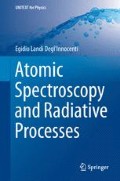Abstract
The radiation that propagates in an extended medium is subject to continuous emission and absorption processes that modify its intensity and spectral distribution. These phenomena are governed by the equation of radiative transfer that we have formally obtained in Chap. 11 from the principles of quantum electrodynamics. By solving this equation, it is possible to relate the observed properties of the radiation emerging from an extended medium with the intrinsic properties of the plasma responsible for its emission. In this chapter, we explore this issue by analysing in detail the prototype case for which the theory of radiative transfer was developed, namely the case of stellar atmospheres. The considerations presented here can be easily extended to deal with specific problems encountered in the analysis of the propagation of radiation in non-astrophysical environments, such as laboratory plasmas or the Earth’s atmosphere.
Access this chapter
Tax calculation will be finalised at checkout
Purchases are for personal use only
Notes
- 1.
In the case of the Sun, given its close proximity and the possibility to perform very detailed observations. appropriate empirical models are also available. These models explicitly take into account the fact that the atmosphere is not strictly in radiative equilibrium. For an in-depth discussion see Landi Degl’Innocenti (2008).
- 2.
An exception are the stars of late spectral type (cool stars) for which the molecules play an important role.
- 3.
At local thermodynamic equilibrium we have \(k_{\mathrm{R}} = k_{\mathrm{R}}^{(\mathrm{a})} \{ 1 - \exp[-h \nu_{0} /(k_{\mathrm{B}} T)] \}\), with \(k_{\mathrm{R}}^{(\mathrm{a})}\) defined in Eq. (11.33).
- 4.
For an in-depth discussion see, for example, Mihalas (1978).
References
Bethe, H.A.: Z. Phys. 57, 815 (1929)
Landi Degl’Innocenti, E.: Fisica Solare. Springer, Milano (2008)
Mihalas, D.: Stellar Atmospheres, 2nd edn. Freeman, San Francisco (1978)
Author information
Authors and Affiliations
Rights and permissions
Copyright information
© 2014 Springer-Verlag Italia
About this chapter
Cite this chapter
Landi Degl’Innocenti, E. (2014). Radiative Transfer. In: Atomic Spectroscopy and Radiative Processes. UNITEXT for Physics. Springer, Milano. https://doi.org/10.1007/978-88-470-2808-1_14
Download citation
DOI: https://doi.org/10.1007/978-88-470-2808-1_14
Publisher Name: Springer, Milano
Print ISBN: 978-88-470-2807-4
Online ISBN: 978-88-470-2808-1
eBook Packages: Physics and AstronomyPhysics and Astronomy (R0)

